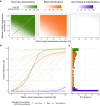Evolving infectious disease dynamics shape school-based intervention effectiveness
- PMID: 40676002
- PMCID: PMC12271494
- DOI: 10.1038/s41467-025-61925-5
Evolving infectious disease dynamics shape school-based intervention effectiveness
Abstract
School-based interventions during epidemics are often controversial, as experienced during the COVID-19 pandemic, where reducing transmission had to be weighed against the adverse effects on young children. However, it remains unclear how the broader epidemiologic context influences the effectiveness of these interventions and when they should be implemented. Through integrated modeling of epidemiological and genetic data from a longitudinal school-based surveillance study of SARS-CoV-2 in 2021-2022 (N children = 336, N adults = 51) and scenario simulations, we show how transmission dynamics in schools changed markedly due to strong increases in community-acquired infections in successive periods of viral variants, ultimately undermining the potential impact of school-based interventions in reducing infection rates in the school-aged population. With pandemic preparedness in mind, this study advocates for a dynamic perspective on the role and importance of schools in infectious disease control, one that adapts to the evolving epidemiological landscape shaped by pathogen characteristics and evolution, shifting public health policies, and changes in human behavior.
© 2025. The Author(s).
Conflict of interest statement
Competing interests: The authors declare no competing interests.
Figures




Similar articles
-
Measures implemented in the school setting to contain the COVID-19 pandemic.Cochrane Database Syst Rev. 2022 Jan 17;1(1):CD015029. doi: 10.1002/14651858.CD015029. Cochrane Database Syst Rev. 2022. Update in: Cochrane Database Syst Rev. 2024 May 2;5:CD015029. doi: 10.1002/14651858.CD015029.pub2. PMID: 35037252 Free PMC article. Updated.
-
Unintended consequences of measures implemented in the school setting to contain the COVID-19 pandemic: a scoping review.Cochrane Database Syst Rev. 2024 Dec 12;12(12):CD015397. doi: 10.1002/14651858.CD015397.pub2. Cochrane Database Syst Rev. 2024. PMID: 39665337
-
Physical interventions to interrupt or reduce the spread of respiratory viruses.Cochrane Database Syst Rev. 2023 Jan 30;1(1):CD006207. doi: 10.1002/14651858.CD006207.pub6. Cochrane Database Syst Rev. 2023. PMID: 36715243 Free PMC article.
-
Education support services for improving school engagement and academic performance of children and adolescents with a chronic health condition.Cochrane Database Syst Rev. 2023 Feb 8;2(2):CD011538. doi: 10.1002/14651858.CD011538.pub2. Cochrane Database Syst Rev. 2023. PMID: 36752365 Free PMC article.
-
Workplace interventions to reduce the risk of SARS-CoV-2 infection outside of healthcare settings.Cochrane Database Syst Rev. 2022 May 6;5(5):CD015112. doi: 10.1002/14651858.CD015112.pub2. Cochrane Database Syst Rev. 2022. Update in: Cochrane Database Syst Rev. 2024 Apr 10;4:CD015112. doi: 10.1002/14651858.CD015112.pub3. PMID: 35514111 Free PMC article. Updated.
References
-
- Cauchemez, S., Valleron, A.-J., Boëlle, P.-Y., Flahault, A. & Ferguson, N. M. Estimating the impact of school closure on influenza transmission from Sentinel data. Nature452, 750–754 (2008). - PubMed
-
- Conto, C. A. et al. COVID-19: Effects of School Closures on Foundational Skills and Promising Practices for Monitoring and Mitigating Learning Loss. (UNICEF Office of Research-Innocenti, 2020).
MeSH terms
Grants and funding
LinkOut - more resources
Full Text Sources
Medical
Miscellaneous

